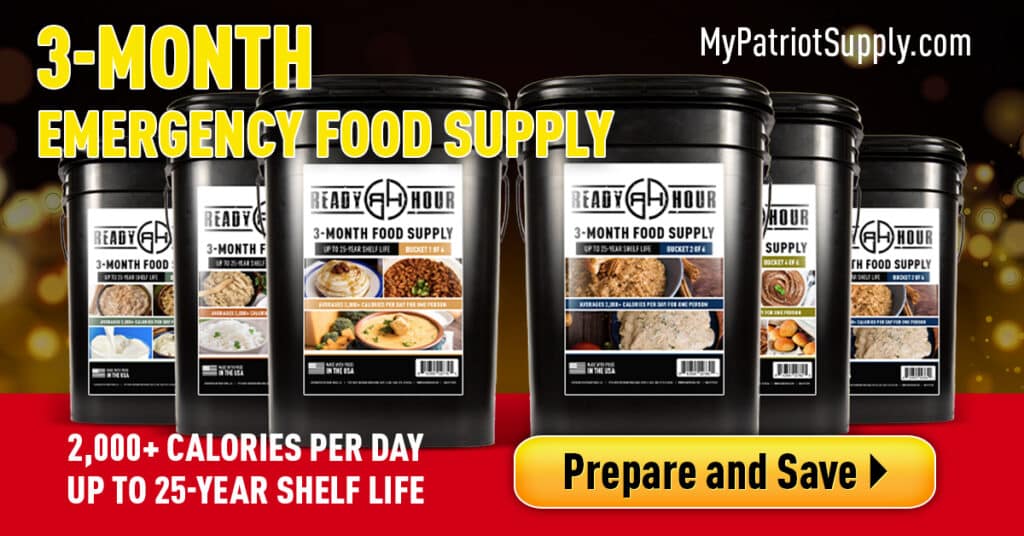Are you prepared for an emergency situation that could leave you without access to food and other essential supplies? Natural disasters, power outages, and other unforeseen circumstances can happen at any time, which is why having an emergency food supply for short-term preparedness is crucial. In this guide, we'll discuss the importance of emergency food supplies, determining your needs, types of emergency foods, essential nutrients, storage and rotation, building your emergency food supply, maintaining it, and additional tips and resources.
Importance of Emergency Food Supply for Short-Term
When disaster strikes, you never know when you might lose access to food and other essential supplies. Having an emergency food supply for short-term preparedness can make all the difference in keeping you and your loved ones safe and healthy during an emergency. Not only does it reduce stress and anxiety, but it can also help you save money by allowing you to buy in bulk and avoid price hikes during emergencies. An emergency food supply can provide peace of mind, knowing that you're prepared for any emergency situation.
Determine Your Needs
Before building your emergency food supply, it's essential to determine your needs. Consider how many people you need to feed, how long you want your supply to last, and any dietary restrictions. The average person needs around 2,000 calories per day, so multiply that by the number of people you need to feed and the number of days you want your supply to last.
Also, consider the types of emergencies you're most likely to face in your area. If you live in an area prone to hurricanes, stock up on non-perishable foods that don't require electricity to prepare. If you live in an area prone to earthquakes, consider foods that are easy to prepare without access to a stove or microwave.
Section Above: Importance of Emergency Food Supply for Short-Term
Section Below: Types of Emergency Foods
| Type of Emergency Food | Pros | Cons |
|---|---|---|
| Canned Foods | Long shelf life, no refrigeration needed, variety of options | Heavy, limited nutrient variety |
| Freeze-Dried Foods | Long shelf life, lightweight, easy to store and transport | Expensive, limited flavor options |
| MREs | Long shelf life, no refrigeration or preparation needed | Expensive, limited flavor options |
| Energy Bars | Lightweight, easy to store and transport, quick energy source | Limited nutrient variety, high sugar content |
It's important to consider the pros and cons of each type of emergency food when building your supply. Canned foods are a good option if you're looking for a variety of options, but they can be heavy and have a limited nutrient variety. Freeze-dried foods are lightweight and easy to store, but they can be more expensive and have limited flavor options. MREs require no preparation and have a long shelf life, but they can be expensive and have limited flavor options. Energy bars provide a quick burst of energy and are easy to store, but they have limited nutrient variety and can be high in sugar.
Types of Emergency Foods
Emergency foods come in several types, and it's essential to choose the right ones for your needs:
Canned Foods
Canned foods are an excellent option for emergency situations. They have a long shelf life and require no refrigeration, making them ideal for power outages or other emergencies. Some popular canned foods include canned fruits, vegetables, meats, and soups.
Freeze-Dried Foods
Freeze-dried foods are another popular option for emergency food supplies. They have a long shelf life and are lightweight, making them easy to store and transport. They also require no refrigeration and can be prepared with just water.
MREs
MREs, or Meals Ready to Eat, are pre-packaged meals designed for military use but available to civilians. They have a long shelf life and require no refrigeration or preparation, making them ideal for emergency situations.
Energy Bars
Energy bars are a convenient option for emergency situations. They're lightweight, easy to store, and can provide a quick burst of energy when you need it most. Choose bars that are high in protein and low in sugar.
Essential Nutrients
When building your emergency food supply, consider the essential nutrients your body needs to function properly:
Protein
Protein is essential for building and repairing tissues and maintaining a healthy immune system. Good protein sources include canned meats, nuts, and energy bars.
Carbohydrates
Carbohydrates provide the body with energy. Good sources of carbohydrates include rice, pasta, and bread.
Fruits and Vegetables
Fruits and vegetables are essential for maintaining a healthy diet. Canned fruits and vegetables are a good option for emergency situations, as they have a long shelf life and require no refrigeration.
Vitamins and Minerals
Vitamins and minerals are essential for maintaining a healthy body. Include a multivitamin in your emergency food supply to ensure you're getting all the nutrients you need.
Storage and Rotation
Proper storage and rotation are essential for maintaining the quality of your emergency food supply. Store your food in a cool, dry place away from direct sunlight. Check the expiration dates regularly and rotate your stock to ensure you're using the oldest items first.
Building Your Emergency Food Supply
When building your emergency food supply, start slowly and build up over time. Purchase a few extra non-perishable items each time you go grocery shopping. Gradually build your supply until you have enough food to last for several days or even weeks.
Incorporating Emergency Foods into Your Regular Diet
Emergency foods don't have to be exclusively for emergency situations. Many canned and freeze-dried foods can be incorporated into your regular diet, saving you time and money. Consider using canned fruits and vegetables in your daily meals or using energy bars as a mid-day snack.
Maintaining Your Emergency Food Supply
Maintaining your emergency food supply is essential for ensuring you're prepared for any emergency situation. Check your supply regularly and rotate your stock to ensure you're using the oldest items first. Use a spreadsheet to track your inventory and expiration dates.
Case Study: Surviving a Power Outage
During a particularly bad winter storm, John and his family lost power for several days. With no way to cook or keep food cold, they quickly realized they were unprepared for the situation. Luckily, they had a small emergency food supply on hand that included canned goods, energy bars, and bottled water. While they had to ration their food carefully, they were able to make it through until power was restored.
After the experience, John and his family decided to invest in a more robust emergency food supply. They determined their needs based on the number of people in their household and the potential length of an emergency. They also researched different types of emergency foods and made sure to include a variety of options to ensure they were getting all essential nutrients.
Now, John feels much more secure in the event of an emergency. He knows that he and his family will be able to weather a power outage or other short-term emergency without worrying about running out of food.
Additional Tips and Resources
Here are additional tips and resources to help you build and maintain your emergency food supply:
- Don't forget about water! It's essential to have a supply of clean drinking water during an emergency.
- Consider purchasing a portable stove or other cooking equipment that doesn't require electricity.
- Include a manual can opener in your emergency kit.
- Check out government websites such as Ready.gov for more information on emergency preparedness.
In conclusion, having an emergency food supply for short-term preparedness is essential for ensuring you and your loved ones are safe and healthy during an emergency situation. Determine your needs, choose the right types of emergency foods, and store and rotate your food properly. Incorporate emergency foods into your regular diet and maintain your supply regularly. Use additional resources to help you prepare and stay informed about emergency preparedness.
Answers To Common Questions
Who should consider having an emergency food supply for short term?
Anyone who wants to be prepared for unexpected situations.
What should be included in an emergency food supply for short term?
Non-perishable items such as canned goods, dried fruits, and protein bars.
How long can an emergency food supply for short term last?
Typically, up to 3 months depending on the amount of food and number of people.
What if I have dietary restrictions or allergies?
Look for specialized emergency food kits that cater to specific dietary needs.
How do I store my emergency food supply for short term?
Store in a cool, dry place away from direct sunlight and extreme temperatures.
What if I don't have the budget for an emergency food supply?
Start small by gradually adding non-perishable items to your pantry each week.
With over a decade of experience in emergency preparedness and survival training, our author is a qualified expert in the field of emergency food supply. They have worked with various organizations to develop and implement emergency response plans, providing them with the knowledge and expertise needed to weather any crisis.
Our author's expertise is based on extensive research and training in the field of emergency preparedness. They have conducted research on the best types of emergency foods and the essential nutrients needed for short-term survival. They have also studied the different storage and rotation techniques required to ensure that emergency food supplies remain fresh and effective.
Our author's work has been featured in several publications and news outlets, including the American Red Cross and the Federal Emergency Management Agency (FEMA). They have also conducted several studies on the effectiveness of emergency food supplies during natural disasters and other crises.
With their extensive experience and knowledge, our author is the ideal guide to help you build and maintain your emergency food supply. So, whether you are a seasoned prepper or just starting out, you can trust our author to provide you with the tools and resources you need to be prepared for any emergency.



